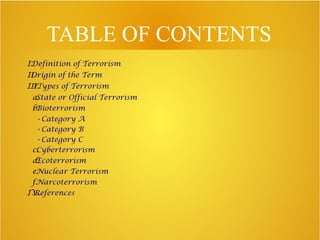
Presentation
- 1. TABLE OF CONTENTS I.Definition of Terrorism II.Origin of the Term III.TTypes of Terrorism a.State or Official Terrorism b.Bioterrorism ➢ Category A ➢ Category B ➢ Category C c.Cyberterrorism d.Ecoterrorism e.Nuclear Terrorism f.Narcoterrorism IV..References
- 2. TERRORISM
- 3. Definition of Terrorism Terrorism ➢ common definitions of terrorism refer only to those violent acts which are intended to create fear (terror); are perpetrated for a religious, political, or ideological goal; and deliberately target or disregard the safety of non-combatants (civilians). ➢ some definitions now include acts of unlawful violence and war. ➢ The concept of terrorism may be controversial as it is often used by state authorities (and individuals with access to state support) to de legitimize political or other opponents, and potentially legitimize the state's own use of armed force against opponents (such use of force may be described as "terror" by opponents of the state).
- 4. Origin of the Term "Terrorism" comes from the French word terrorisme, and originally referred specifically to state terrorism as practiced by the French government during the Reign of terror. The French word terrorisme in turn derives from the Latin verb terreō meaning “I frighten”.
- 5. Types of Terrorism A.State or Official Terrorism States can use force or the threat of force, without declaring war, to terrorize citizens and achieve a political goal. Original form/type of terrorism. It may also be referred to as “Structural Terrorism” defined broadly as terrorist acts carried out by governments in pursuit of political objectives, often as part of their foreign policy. Example: The 1793 French Revolution and the thousands of executions that resulted are often cited as the first instance of state terrorism, though rulers have plausibly been using it for centuries to control their subjects. .
- 6. State or Official Terrorism
- 7. Types of Terrorism B. Bioterrorism It is the intentional release of toxic biological agents to harm and terrorize civilians, in the name of a political or other cause. The U.S. Center for Disease Control has classified the viruses, bacteria and toxins that could be used in an attack.
- 8. Types of Agent: 1.Category A - most likely to do the most damage. a. Anthrax (Bacillus anthracis) - has a very low fatality rate if treated, but can severely incapacitate b.Botulism (Clostridium botulinum toxin - serious illness that causes flaccid paralysis of muscles c.The Plague (Yersinia pestis) - disease that has a high mortality rate or a calamity with widespread and serious consequences for its victims d.Smallpox (Variola major) - produces a more serious disease and has an overall mortality rate of 30–35% ; Long-term complications include characteristic scars, commonly on the face, which occur in 65–85% of survivors e.Tularemia/Rabit Fever (Francisella tularensis) – people who inhale this would generally experience severe respiratory illness, including life- threatening pneumonia and systemic infection, if they are not treated
- 9. 2. Category B - moderately easy to disseminate a. Brucellosis (Brucella species) b.Epsilon toxin of Clostridium perfringens c. Food safety threats (e.g., Salmonella species, Escherichia coli O157:H7, Shigella) d.Glanders (Burkholderia mallei) e. Melioidosis (Burkholderia pseudomallei) f. Psittacosis (Chlamydia psittaci) g.Q fever (Coxiella burnetii) h.Ricin toxin from Ricinus communis (castor beans) i. Staphylococcal enterotoxin B j. Typhus fever (Rickettsia prowazekii) k.Viral encephalitis (alphaviruses [e.g., Venezuelan equine encephalitis, eastern equine encephalitis, western equine encephalitis]) l. Water safety threats (e.g., Vibrio cholerae, Cryptosporidium parvum
- 10. 3. Category C - emerging pathogens that could be engineered for mass dissemination in the future because of: ➢ availability; ➢ ease of production and dissemination; and ➢ potential for high morbidity and mortality rates and major health impact a. Nipah Virus b.Hanta Virus
- 11. BIOTERRORISM
- 12. TYPES OF TERRORISM c. Cyberterrorism ➢ use information technology to attack civilians and draw attention to their cause. ➢ this may mean that they use information technology, such as computer systems or telecommunications, as a tool to orchestrate a traditional attack. ➢ refers to an attack on information technology itself in a way that would radically disrupt networked services
- 13. CYBERTERRORISM
- 14. TYPES OF TERRORISM D. Ecoterrorism ➢ coined term describing violence in the interests of environmentalism ➢ in general, environmental extremists sabotage property to inflict economic damage on industries or actors they see as harming animals or the natural enviroment ➢ It includes fur companies, logging companies and animal research laboratories, for example.
- 15. ECOTERRORISM
- 16. TYPES OF TERRORISM E. Nuclear Terrorism ➢ a number of different ways nuclear materials might be exploited as a terrorist tactic ➢ these include attacking nuclear facilities, purchasing nuclear weapons, or building nuclear weapons or otherwise finding ways to disperse radioactive materials.
- 18. TYPES OF TERRORISM E. Narcoterrorism ➢ it once denoted violence used by drug traffickers to influence governments or prevent government efforts to stop the drug trade ➢ in the last several years, it has been used to indicate situations in which terrorist groups use drug trafficking to fund their other operations.
- 19. NARCOTERRORISM